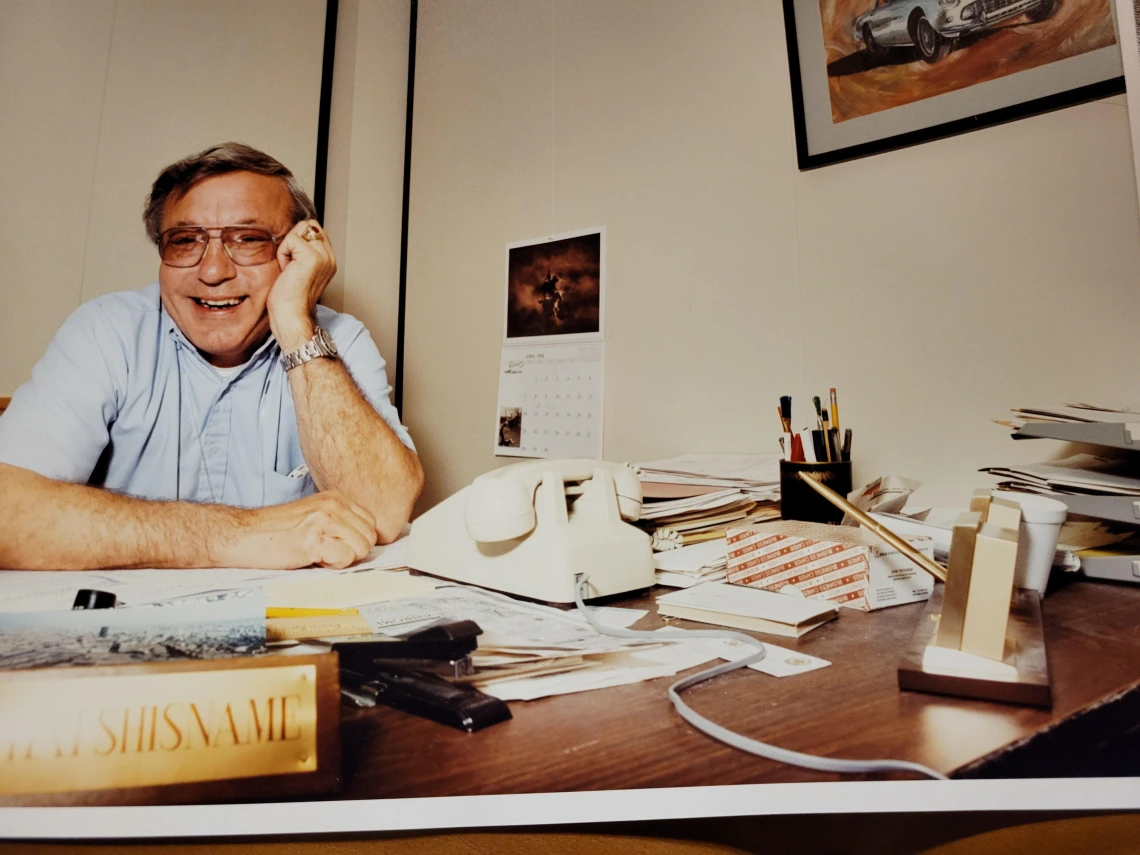John Tsitouras Looks Back on 66 Years Since Graduation
A man with a knack for all things electrical and mechanical is among the College of Engineering’s oldest alumni.

John Tsitouras, seen here at his desk at EG&G in Las Vegas, earned his electrical and computer engineering degree in 1955.
John Tsitouras grew up in Iowa during the Great Depression. His family didn’t have electricity or running water, and he attended a one-room country school. But he always had a mind for the technical. He was 10 when he built his first radio with a vacuum tube and copper from a Whippet generator.
“The damn thing even worked!” said Tsitouras, who earned his bachelor’s degree in electrical engineering from the University of Arizona in 1955. “It was amazing. In fact, we used it to listen to the radio, because we didn’t have one until I built one.”
At 11, he built electric fencing for farmers in the area based on a Model T Ford coil – and when he went home for his 50th high school reunion, the fencing was still working. He kept his mother’s washing machine and sewing machine running throughout his childhood and adolescence, and he even started repairing the typewriters at his high school when the original repairman was drafted for World War II.
“I think we’re all just born with certain characteristics, and I was certainly born with the idea that I was always going to be in the scientific world,” he said. “If it was electrical or mechanical, I could handle it, and I did. Not only that, but I had a lot of fun doing it, always. It wasn’t work — it was a pleasure. And it still is to this very day.”
A Lifelong Love of Learning
Tsitouras was at the top of his high school class of 1943, and he loved learning. He even started studying at Iowa State University during his last semester of high school. This was unusual in a time when the country was still feeling the effects of the Great Depression, and, as Tsitouras put it, “You were lucky to have a nickel to buy a candy bar.”
However, Tsitouras decided to join the U.S. Navy, and headed off to bootcamp two days after his high school graduation. Serving his country also wound up being his ticket to further education, as he attended electronics schools in Chicago and in Corpus Christi, Texas. He’d already taught himself much of the content, but he knew there was always room to learn, and he embraced the opportunity.
After the military, he went to work for Philco in Hickam Field, then in San Diego. But living in a dry area improved his asthma, so he decided to study electrical engineering at the University of Arizona. For part of his education, he lived in a Quonset hut, a scorching environment in the Arizona summer, without any air conditioning. In fact, the only building on campus at the time with air conditioning was the then-new student union. So, Tsitouras took matters into his own hands.
“I made my own air conditioner and had the only Quonset hut in Polo Village with air conditioning” he said. “This was in Tucson, Arizona! It’s hotter than hell in the summer, and you need AC badly.”
His home improvement caused quite a stir, as his air conditioner meant Tsitouras was using more electricity than other students. So he worked out a plan to pay for his utilities separately.
He stayed busy outside of class manning a 36-inch telescope for the astronomy department for 35 cents an hour and working as a campus lifeguard. He also started his own business, John’s Radio and Television, repairing televisions and radios. When pianist Ferde Grofe gave a concert at the university, Tsitouras built a Klipschorn for the occasion – the same one that now sits in Tsitouras’s den.
He enjoyed his time as a student, where he got to learn something new every day. Transistors were growing in popularity at the time, and for his senior project, Tsitouras created circuits demonstrating how vacuum tubes could be replaced by transistors.
“It was in a time when electronics were still changing very fast,” he said. “Now some of it is pretty well established, and I don’t have a bit of trouble looking at modern electronic TVs. I’ve kept up with a lot of changes over the years.”
Beyond College, From Howard Hughes to Pebble Beach
His first job after graduation was with the Howard Hughes Corporation. He was even neighbors with Howard Hughes’ crew chief from the flight around the world, and he got to know Howard Hughes personally during evenings spent outside smoking and touring the plant.
From there, he went on to work for companies such as Convair, where he was the test conductor on the Atlas missile project, and for EG&G, where he worked on projects ranging from the timing and firing of atomic bombs to the development of seismometers.
Since his retirement, he’s had more time for his hobby of collecting and refurbishing rare and exotic cars. He even showed one of his classic cars at Pebble Beach and worked as a docent at a car museum in Las Vegas for a period. He also has a collection of machinery in his basement, including a metal lathe, a drill press and a milling machine.
“I still like to fiddle around with anything mechanical and electrical,” he said. “To this day, I can hardly resist whatever needs fixing. If you’re not careful, I’ll have it apart if I’m invited over for dinner or something.”

